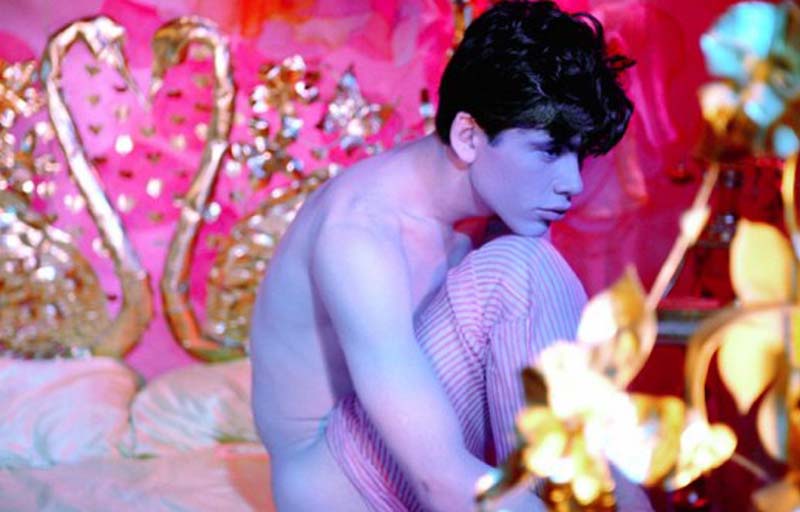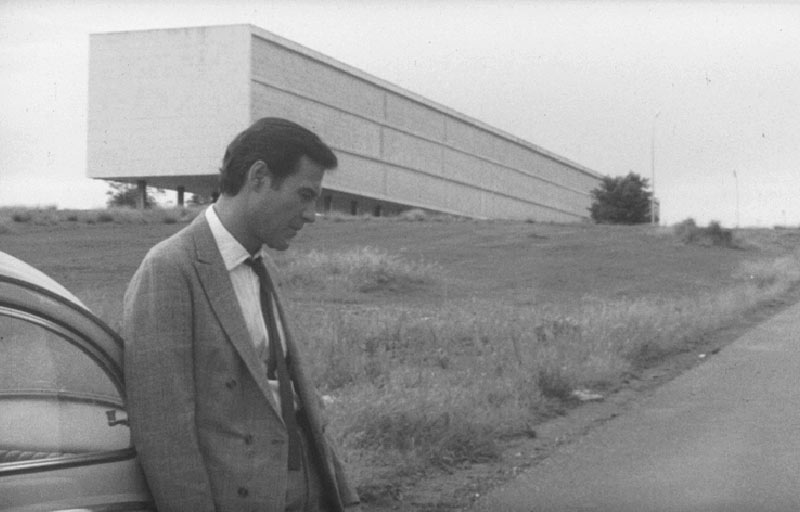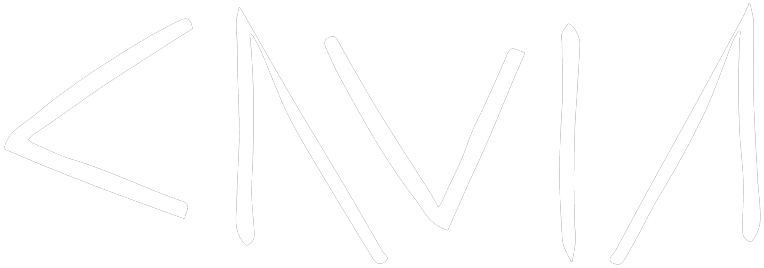Januari
| Vr. 10 |
: Pink Narcissus |
| Za. 11 |
: Antes, o Verão (Before, Summer) |
| Zo. 12 |
: Amor e Desamor (Love and Unlove) |
| Vr. 17 |
: Pink Narcissus |
| Ma. 20 | : Excellent Suits |
| Ma. 20 |
: Les Années Scopitones – Jukebox Movies from the 1950s & 1960s |
| Wo. 22 |
: Dissidences - an evening with Raisa Maudit |
| Vr. 24 |
: Fish Story |
Vrijdag 10 januari, 20:30
Vrijdag 17 januari, 20:30
CLASSIC
Pink Narcissus
James Bidgood | 1971 | Verenigde Staten | 65'

NL Een erotische en lyrische ontdekkingsreis door de fantasieën van een jonge homoseksuele schandknaap. Pink Narcissus is een cultklassieker van grootse esthetische en queer belangen. Een ode aan het sensuele escapisme. Een weelderige, decadente en hallucinogene atmosfeer. De viering van het mannenlichaam en queerness. Een onontkoombare visuele inspiratie voor types als David Lachapelle, Pierre et Gilles en voor vele andere liefhebbers van kitch, en één van de mijlpalen in underground gay cinema.
EN An erotic and lyrical exploration of the fantasies of a young gay hustler, Pink Narcissus is a cult classic of great aesthetic and queer importance. An ode to sensual escapism. A lush, decadent and hallucinogenic atmosphere. A celebration of the male body and queerness. And an undeniable visual inspiration for the likes of David Lachapelle, Pierre et Gilles and many other lovers of kitsch -- one of the most unforgettable landmarks of underground gay cinema.
Zaterdag 11 januari, 20:30
CLASSIC
Antes, o Verão (Before, Summer)
Gerson Tavares | 1968 | Brazilië | 80' | EN subs

NL Cinema Novo was een beweging die, onder invloed van het Italiaanse neorealisme en de Franse Nouvelle Vague, in 1952 ontstond in Brazilië. Met Glauber Rocha als een van de sleutelfiguren bracht de beweging een rijke filmografie voort in welke het achterland en de moderne stad naast elkaar bestonden. Deze tijd bracht een serie Braziliaanse filmmakers wiens films tot op de dag van vandaag nog relatief onbekend zijn. Gerson Tavares is zo’n filmaker. Zijn intieme portretten over het conflict tussen mens, stad en natuur, uitgedrukt in zijn unieke cinematografische taal, verdienen het om nader beschouwd te worden. Onder coördinatie van onderzoeker Rafael de Luna Freire, hoogleraar aan de Universidade Federal Fluminense, heeft recent restauratiewerk een aantal van Tavares’ opmerkelijke films gered. Filmhuis Cavia vertoont in januari twee van zijn verbluffende speelfilms, gekoppeld aan een even memorabele korte film van zijn hand.
Zich afspelend in Cabo Frio, volgt Antes, o Verão Luís’ en Maria Clara’s verblijf met hun kinderen in hun vakantiehuis. De kinderen vinden het lichaam van een man, die het slachtoffer was van een ongeluk met vluchtmisdrijf, op straat dicht bij het huis. Dit zorgt voor een crisis in de relatie tussen het koppel. Luís ontmoet Dréia, met wie hij een affaire aangaat. In de tussentijd verdenkt een politieagent die onderzoek doet naar de dood van het slachteroffer Maria Clara ervan dat zij de schuldige is in het vluchtmisdrijf.
EN Cinema Novo was created in Brazil in 1952 under the influence of the Italian neorealist movement and the Nouvelle Vague. With Glauber Rocha as one of its key figures, Cinema Novo consolidated a rich filmography in which references to the hinterland and modern cities co-existed. During this time, a series of Brazilian filmmakers emerged whose films remain largely unknown to the public to this day. Gerson Tavares is one of them. Taveres’ intimate portrayals of the conflict between the human, the urban, and the natural expressed in his unique cinematographic language deserves to be revisited. Under the coordination of researcher Rafael de Luna Freire, professor at the Brazilian Fluminense Federal University, a recent restoration of Tavares' work rescued some of his most remarkable films. At Filmhuis Cavia in January, we will be showing Gerson Tavares’ two stunning feature films, paired with an equally memorable short film.
Set in Cabo Frio, Antes, o Verão follows Luís’ and Maria Clara’s stay with their children in their summer house. The couple’s children find the body of a man who was the victim of a hit-and-run incident on a road near the house. A crisis between the couple ensues. Luís meets Dréia, with whom he starts an affair. Meanwhile, a policeman investigating the man’s death suggests that Maria Clara is the perpetrator of the crime.
+
Gafieira
Gerson Tavares | 1972 | Brazilië | 12’ | geen dialoog
NL Gafieira beschrijft de gebeurtenissen van een zaterdagnacht tijdens het carnaval van Rio de Janeiro en is gefilmd in de beroemde ‘Elite’. Gebruikmakend van direct geluid documenteert de film trouw alle stadia van het feest: de voorbereidingen in de zaal, de bar, de vaste bezoekers, het orkest, de muziek, de dans en de karakteristieke types. Samen vormen ze een rijk paneel van kracht en poëzie.
EN Covering the occurrences of a Saturday night at a Rio carnival, Gafieira was filmed in the famous 'Elite.' Using direct sound, the film faithfully documents all the stages of the party: the preparation of the hall, the bar, the regulars, the orchestra, the music, the dance and the characteristic types, all forming a rich panel of power and poetry.
Zondag 12 januari, 20:30
CLASSIC
Amor e Desamor (Love and Unlove)
Gerson Tavares | 1966 | Brazilië | 90' | EN subs

NL Cinema Novo was een beweging die, onder invloed van het Italiaanse neorealisme en de Franse Nouvelle Vague, in 1952 ontstond in Brazilië. Met Glauber Rocha als een van de sleutelfiguren bracht de beweging een rijke filmografie voort in welke het achterland en de moderne stad naast elkaar bestonden. Deze tijd bracht een serie Braziliaanse filmmakers wiens films tot op de dag van vandaag nog relatief onbekend zijn. Gerson Tavares is zo’n filmaker. Zijn intieme portretten over het conflict tussen mens, stad en natuur, uitgedrukt in zijn unieke cinematografische taal, verdienen het om nader beschouwd te worden. Onder coördinatie van onderzoeker Rafael de Luna Freire, hoogleraar aan de Universidade Federal Fluminense, heeft recent restauratiewerk een aantal van Tavares’ opmerkelijke films gered. Filmhuis Cavia vertoont in januari twee van zijn verbluffende speelfilms, gekoppeld aan een even memorabele korte film van zijn hand.
Amor e Desamor is een existentieel drama over het leven van twee individuen: een architect die net zijn baan heeft verlaten en een moderne, getrouwde vrouw die interesse heeft in een ongebonden affaire. Bij toeval ontmoeten ze elkaar in zijn huis, gemaakt van hout en steen en staand tussen de bomen, sterk contrasterend met het betonnen landschap van het nieuwgebouwde Brasilia. Een beetje verlegen en introvert voelt de architect een enorme aantrekkingskracht tot de schijnbaar dominerende, rustige en bekwame vrouw. De botsing tussen de twee persoonlijkheden is een primitieve, maar ook elegante strijd, in welke sensualiteit altijd aanwezig is.
EN Cinema Novo was created in Brazil in 1952 under the influence of the Italian neorealist movement and the Nouvelle Vague. With Glauber Rocha as one of its key figures, Cinema Novo consolidated a rich filmography in which references to the hinterland and modern cities co-existed. During this time, a series of Brazilian filmmakers emerged whose films remain largely unknown to the public to this day. Gerson Tavares is one of them. Taveres’ intimate portrayals of the conflict between the human, the urban, and the natural expressed in his unique cinematographic language deserves to be revisited. Under the coordination of researcher Rafael de Luna Freire, professor at the Brazilian Fluminense Federal University, a recent restoration of Tavares' work rescued some of his most remarkable films. At Filmhuis Cavia in January, we will be showing Gerson Tavares’ two stunning feature films, paired with an equally memorable short film.
Amor e Desamor is an existentialist drama revolving around the life of two individuals: an architect who has just left his job and a modern married woman interested in a casual love affair. By chance, they meet one night in his house, made of wood and bricks, among the trees, contrasting with the city of Brasilia's newly-built concrete landscape. A little shy and introverted, he feels a violent attraction to the seemingly domineering, calm, and accomplished woman. The clash between the two personalities is a primitive and refined struggle in which sensuality is always present.
Maandag 20 januari, 19:00
SPECIAL
Excellent Suits
(co-presented by Images Festival) | 60’ | EN subs

NL De naam van het programma deze avond ontleent zich uit een interview met videokunstenaar Maureen Bradley in Lorna Boschmans documentaire Boy Girl (1999), waarin ze drie perspectieven geeft op het androgyne leven. In de film sprak Bradley over haar flucturerende modegevoel in haar jeugd toen ze in een band optrad als een mod femme en kringloopwinkels bezocht en 'get these really excellent suits'. Vertrekkend vanuit het eufemisme 'adamskostuum' om te verwijzen naar het naakte lichaam, tonen de werken in dit programma manieren van dat zo’n kostuum altijd kan worden aangeraakt, weerlegd en op maat gemaakt. Meer info→
EN The title of this program is pulled from Lorna Boschman’s interview with video artist Maureen Bradley in her documentary Boy Girl (1999) which offers three perspectives on androgynous life. In the film, Bradley spoke about her fluctuating fashion sense in her youth when she performed in a band as a mod femme and excavate thrift stores and “get these really excellent suits.” In selecting the works in this program, Ling considered the euphemism for a naked body, a birthday suit, and works that present ways that such a suit can be touched, refuted, and tailored — to be in one’s most excellent suit.
More info→
Maandag 20 januari, 20:30
SPECIAL
Les Années Scopitones – Jukebox Movies from the 1950s & 1960s
Diverse regisseurs | 1958-1978 | Frankrijk/divers | no subs

NL Scopitones (1958-1978), de voorlopers van videoclips, werden afgespeeld in jukebox-achtige apparaten met ingebouwde monitoren. Je kon ze vinden op treinstations, in bars en in veel andere publieksruimten, altijd dorstig naar kleingeld. Ze bevatte meestal materiaal geschoten op één locatie, restanten van opnames van speelfilms. Vanavond kun je originele 16mm-kopieën ervaren met het easy listening-geluid van Sylvie Vartan, Petula Clark, Dalida, Debbie Reynolds, Claude Francois, Danyel Gérard, Bobby Vee, de Kessler-Zwillinge en vele, vele anderen. Leun achterover, doe een relaxt dansje en geniet van sweet swingin’ mondo bizarro of Scopitone madness!
Introductie met Bernd Brehmer van Werkstattkino München!
EN Scopitone-Clips (1958-1978), predecessors of MTV music videos were played on coin-fed jukebox-like devices featuring built-in monitors. One could find them in train stations, bars and other public places. They typically featured footage shot on one location, in leftover scenographies of feature films, in forests or in front of shabby wallpapers. You can experience original 16mm analogue copies feat. the easy listening sound of Sylvie Vartan, Petula Clark, Dalida, Debbie Reynolds, Claude Francois, Danyel Gérard, Bobby Vee, The Kessler twins among many others. Lean back, relax dance and enjoy sweet swingin’ mondo bizarro of Scopitone madness!
Introduction with Bernd Brehmer of Werkstattkino Munich!
Woensdag 22 januari, 20:30
ART
Dissidences - an evening with Raisa Maudit

NL Een avond met films van Spaanse visuele kunstenaar Raisa Maudit. Haar werk gaat over de representatie van lust, constructies, tegenstellingen en verwachtingen. Vaak in de vorm van een vraag, een wijzende vinger of een klein opstandje. Raisa’s video’s zijn daden van omverwerping en non-acceptatie. Postanarchisme, transfeminisme, populaire cultuur, identiteit, het lichaam als een gereedschap en het occulte zijn sommige van haar terugkerende thema’s. De kunstenaar is bij de vertoning aanwezig voor een Q&A na afloop. Meer info→
EN An evening with films by Spanish visual artist, Raisa Maudit. Her work draws on representations of desire, constructions, contradictions and expectations. Often in the form of a question, a pointing finger or a small rebellion, Raisa's videos are acts of subversion and dissent. Postanarchism, transfeminism, popular culture, identity, the body as a tool and the occult are some of her recurring themes. The artist will be present for a Q&A after the screening. More info→
Vrijdag 24 januari, 20:30
CONTEMPORARY
Fish Story
Yoshihiro Nakamura | 2009 | Japan | 112' | EN subs

NL Een eenzame man meandert op zijn scooter door de schijnbaar verlaten straten van Tokio. Vuilnis ligt op straat, auto’s zijn verlaten, er is geen levende ziel te zien. Behalve dan bij een merkwaardige, kleine platenzaak. De man lijkt geïrriteerd dat de eigenaar van deze zaak – een zonderlinge en buitengewoon rustige, oude man – zijn winkel heeft geopend op de dag dat een allesvernietigende komeet richting de Aarde schiet. De oude man is echter niet bang: hij vertrouwt op het obscure Japanse punklied uit de jaren ’70 dat op de achtergrond speelt. En zo begint Fish Story, een oneven en gefractureerde odyssee van een punklied die voortkomt uit een mislukte vertolking van de enige overgebleven kopie van Fish Story, een boek uit het naoorlogse Japan. Als een pionierende punkband dit boek in 1975 herinterpreteerd als een lied, verdwijnt deze groep van de aardbodem kort na het uitbrengen van deze beruchte herinterpretatie. Het wordt heruitgevonden als een broodjeaapverhaal dat uiteindelijk de wereld redt van de Maya-voorspelling over het jaar 2012. Een surrealistisch en geestig verhaal dat een raar vlindereffect openbaart...
EN A lone man meanders through the seemingly deserted streets of Tokyo on his scooter. Garbage is strewn in the streets; cars are abandoned; there is not a soul in sight – except at a strange little record shop. The man seems annoyed that the owner, an odd and exceedingly calm old man, would open his store on the day a comet is racing towards the Earth that will inevitably cause its destruction. But the old man is not concerned; he trusts the obscure Japanese punk song from the 1970s playing in the background. And so begins Fish Story, a disparate and fractured odyssey of a punk song that emerges from a botched rendition of the only remaining copy of Fish Story, a book from postwar Japan, is re-interpreted by a 1975 pioneering punk band that vanishes upon releasing the infamous song, and is reinvented as an urban legend that ultimately saves the world from the 2012 Mayan prophecy. A surreal and amusing story that reveals a strange butterfly effect...
